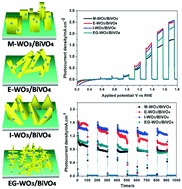Morphology engineering of WO3/BiVO4 heterojunctions for efficient photocatalytic water oxidation†
Abstract
Four types of nanostructural WO3/BiVO4 heterojunctions were designed by depositing a BiVO4 layer onto WO3 scaffolds with different morphologies and investigated to understand the influence of heterojunction morphology on their photoelectrochemical performances. The architecture of WO3 scaffolds was controlled by adjusting the solvents used in their solvothermal synthesis. The solvent was found to exert a great influence on the architecture of the obtained WO3 scaffolds. Methanol leads to the formation of block-like nanostructures and ethanol facilitates the formation of nanorods, while isopropyl alcohol and ethylene glycol give rise to the formation of triangular nanowalls and 3D hierarchical nanostructures, respectively. Monoclinic WO3 nanostructures were obtained via removal of ammonium or structural water by annealing the samples obtained at 510 °C in air. A BiVO4 layer was then deposited on the monoclinic WO3 scaffolds with different morphologies by spin-coating to form WO3/BiVO4 heterojunction films, which show significantly enhanced photocurrents compared to their corresponding bare WO3 scaffolds. Among these WO3/BiVO4 nanostructure heterojunctions, the one based on a rod-like WO3 nanostructure shows the best photoelectrochemical (PEC) performance, which can be ascribed to its optimal rod-like morphology, for the construction of WO3/BiVO4 heterojunction regarding efficient charge carrier transfer and collection, while the other one based on WO3 nanowalls exhibits better stability and a higher photocurrent in a long-run test, indicating that morphology engineering significantly influences the activity and stability of WO3-based heterojunctions.



 Please wait while we load your content...
Please wait while we load your content...